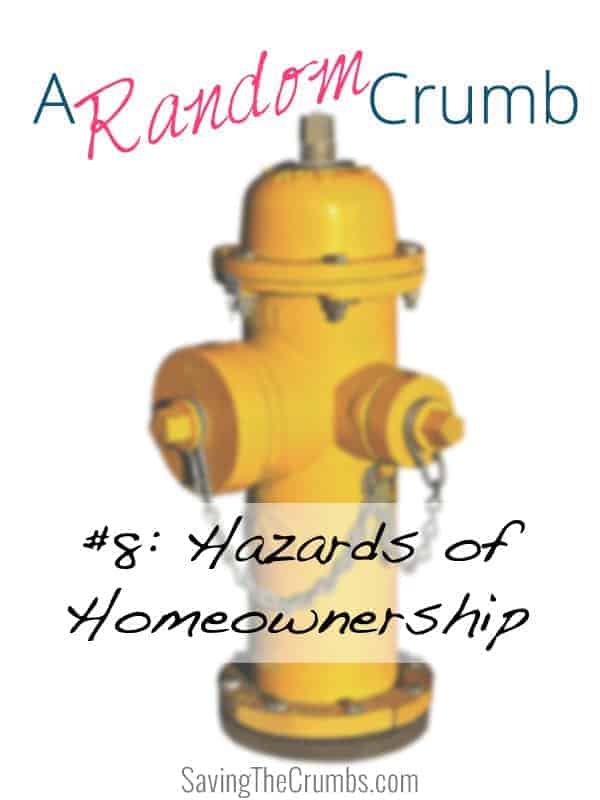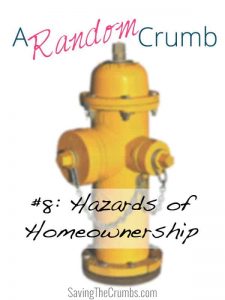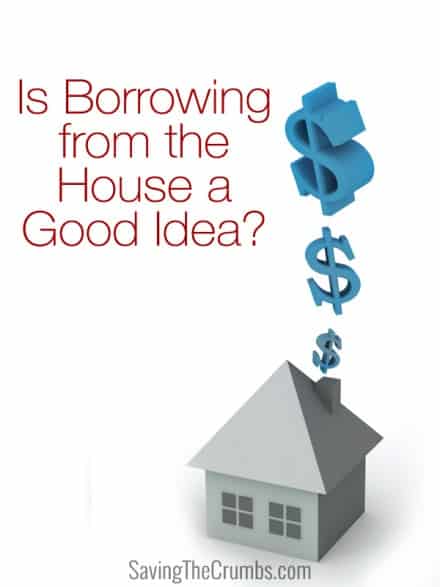Every once in a while, the Crumb Saver household shares a snapshot of a recent crumb-saving (or wasting!) incident on A Random Crumb. This column is proof that, hey, we’re people just like you! Prepare for a little randomness, a little embarrassment, but hopefully mostly encouragement. You’ll get a sneak peek at what we actually do to save (or NOT save) in real life, which is motivation to us to stay crumby (in the good way) and (hopefully) inspiration for you join in the crumb-saving action too!
Today, I want to tell you a sad story.
A Deep Problem
About two months ago, we discovered that the water main connecting the water meter and our house had sprung a leak. When we got our water bill, it was much higher than usual—DOUBLE, in fact! As you can imagine, we were outraged at such an unnecessary loss of crumbs. (Even though the bill had only gone from $10 to $20.)
My father-in-law was visiting us during that time and he offered to try to find the leak. So he started digging for the buried pipe in our front lawn. 12 inches down (the minimum depth required in our area), and there was no pipe. 18 inches down. Still no pipe. 24 inches down. STILL no pipe. At that point, we realized that we weren’t going to have an easy time locating a small leak along a pipe that’s at least 100 feet long that’s buried so deep in the ground!
So we called a plumber for professional assistance, but he went down over 36 inches and he STILL couldn’t reach the pipe! Perhaps the water line was laid down prior to additional leveling and grading was done on the lawn on top of it, but that pipe was deep in the bowels of our yard, and there was no way to find it without doing some major excavation.
Then it started raining. And raining. And RAINING.
In fact, over the next several weeks, we received the highest amount of rainfall for December ever in our area! This rendered our lawn a giant mud slick with no possibilities of finding a small leak in a pipe over three feet underground. All the while, that leak continued to cost us money every single day.
When It Dried Up…
By the time the rain stopped, we had gotten our next water bill. It had gone up three times from what we originally pay. Yes, yes it’s still “only” $30 compared to $10, but the point was that the leak was getting worse. So we knew this wasn’t something we could ignore indefinitely.
The plumber had shared that since the leak was so small and the pipe so far underground, they would need to dig up our entire lawn to get to it. Not only would that destroy our yard, it would also cost a fortune. Instead, we might as well lay a whole new line at a more reasonable depth. The cost would be nearly the same to go either route—nearly $1000!
So should we pay the big bucks to lay in a new water line for a water bill that was only an extra $20/month? The leak was getting definitely worse, so something had to be done. What to do?
In the end, the plumber suggested that we “sleeve” our current pipe with a new PEX lining. In other words they would slide a narrower diameter flexible pipe inside the existing water main to fix it. Not only would they not need to tear up our yard, but it also would be way faster and cheaper to implement. It still cost us $650, but it made a lot more sense to us to go that route.
Thus we unexpectedly parted with $650 in the first days of 2016. But wait, that’s not the end of this sad tale.
The Tragedy Continues
We went on our merry way for a few days until we noticed a GIANT pool of water sitting in the drain pan of our hot water heater. A quick evaluation revealed that our electric water heater had sprung leaks in two places: the top heating element and also the T&P (temperature and pressure release) valve. Apparently the difference in water pressure (which wasn’t THAT big) following the water main fix caused our aging water heater to leak at its weak spots.
Just to see if it was a leaky gasket, I replaced the element with a new one—but no, the leak just continued. The T&P valve also was leaking around the weld so we came to the sad realization that our 16-year old water heater needed to be replaced too. Sigh.
A Hopeful Moment
At this point, I realized that this might be an opportunity to upgrade our hot water heater to a higher efficiency one. I had read about hybrid electric hot water heaters (like this one) that by using heat pump technology were nearly three times more efficient than regular electric hot water heaters and could save up to two-thirds of the water-heating bill (likely the highest source of energy consumption in our home). Moreover, there were loads of tax credits and utility rebates to be had to drive down the cost. (I could have gotten over $500 back in total.)
So for just slightly more than a regular heater, I could upgrade to one that would pay itself off in less than 3 years! Yeah, sign me up!
But it was not to be.
Reality set in when I realized that my laundry room was simply too small to accommodate the larger space requirements of the new unit. Bummer! So that fleeting moment when I thought that the lemons might yet be turned into lemonade turned to bitter gall in my Crumb Saver mouth.
So in the end, we replaced our 16 year-old, energy-guzzling electric hot water heater with a new energy-guzzling electric hot water heater for $700–with little to no energy savings going forward. 🙁
The Moral of the Story
Before the conclusion of the first month of the year, we’ve already spent over $1300 on unexpected home repair expenses. So what can we learn from this story?
- Emergency Fund – These are reasons why everyone should have money saved in an emergency fund. There should be no need to go into debt for a few water leaks. (Fortunately, we didn’t need to tap into our official emergency fund but just pulled some of our home improvement savings. It will just delay some of our other purchases there.)
- Knowledge – It’s tremendously helpful to have some basic knowledge about how things work around the house. You’ll save lots of money if you have the skills and time to fix the things yourself too!
- Efficiency Upgrades – When things break and it’s time to replace them anyway, it is a good idea to see if there are more efficient options to upgrade to that will save you money in the long run.
- Home Ownership – These types of things WILL happen to you as a homeowner. These expenses aren’t advertised as part of the cost of homeownership. Consider them well before committing to buy a home. You may decide you’d prefer to just call your landlord when issues like these come up and skip the hazards of homeownership.
- Peace of Mind – There’s the issue of peace of mind. It is great to live in our own home (especially when it’s paid off!), but there’s a flip side to that peace of mind coin. What if the water heater flooded the house while we were away on one of our trips? What if the leak in the water pipe was far more severe and we couldn’t fix it during the torrential rain for weeks? Any investment involves risk, and that includes owning a home.
- Take Care of Your Home – Just like any other possession that we have, we should take care of our home and it will provide years of blessings for us and our families.
Calling all you homeowners out there. What are some other “hazards of homeownership” that you’ve experienced? Any words from the wise for those considering buying a home?







